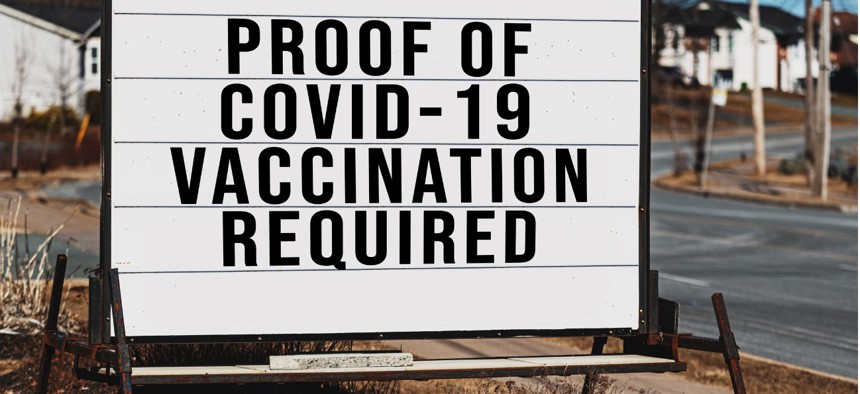
shauni / istock
Most Vaccine-Hesitant People Remain Willing to Change Their Minds
A new study shows people's views are not set in stone. The director of the National Institutes of Health explains.
As long and difficult as this pandemic has been, I remain overwhelmingly grateful for the remarkable progress being made, including the hard work of so many people to develop rapidly and then deploy multiple life-saving vaccines. And yet, grave concerns remain that vaccine hesitancy—the reluctance of certain individuals and groups to get themselves and their children vaccinated—could cause this pandemic to go on much longer than it should.
We’re seeing the results of such hesitancy in the news every day, highlighting the rampant spread of COVID-19 that’s stretching our healthcare systems and resources dangerously thin in many places. The vast majority of those currently hospitalized with COVID-19 are unvaccinated, and most of those tragic 2,000 deaths each day could have been prevented. The stories of children and adults who realized too late the importance of getting vaccinated are heartbreaking.
With these troubling realities in mind, I was encouraged to see a new study in the journal JAMA Network Open that tracked vaccine hesitancy over time in a random sample of more than 4,600 Americans. This national study shows that vaccine hesitancy isn’t set in stone. Over the course of this pandemic, hesitancy has decreased, and many who initially said no are now getting their shots. Many others who remain unvaccinated lean toward making an appointment.
The findings come from Aaron Siegler and colleagues, Emory University, Atlanta. They were interested in studying how entrenched vaccine hesitancy would be over time. The researchers also wanted to see how often those who were initially hesitant went on to get their shots.
To find out, they recruited a diverse, random, national sampling of individuals from August to December 2020, just before the first vaccines were granted Emergency Use Approval and became widely available. They wanted to get a baseline, or starting characterization, on vaccine hesitancy. Participants were asked two straightforward questions, “Have you received the COVID-19 vaccine?” and “How likely are you to get it in the future?” From March to April 2021, the researchers followed up by asking participants the same questions again when vaccines were more readily available to many (although still not all) adults.
The survey’s initial results showed that nearly 70 percent of respondents were willing to get vaccinated at the outset, with the other 30 percent expressing some hesitancy. The good news is among the nearly 3,500 individuals who answered the survey at follow-up, about a third who were initially vaccine hesitant already had received at least one shot. Another third also said that they’d now be willing to get the vaccine, even though they hadn’t just yet.
Among those who initially expressed a willingness to get vaccinated, about half had done so at follow up by spring 2021 (again, some still may not have been eligible). Forty percent said they were likely to get vaccinated. However, 7 percent of those who were initially willing said they were now less likely to get vaccinated than before.
There were some notable demographic differences. Folks over age 65, people who identified as non-Hispanic Asians, and those with graduate degrees were most likely to have changed their minds and rolled up their sleeves. Only about 15 percent in any one of these groups said they weren’t willing to be vaccinated. Most reluctant older people ultimately got their shots.
The picture was more static for people aged 45 to 54 and for those with a high school education or less. The majority of those remained unvaccinated, and about 40 percent still said they were unlikely to change their minds.
At the outset, people of Hispanic heritage were as willing as non-Hispanic whites to get vaccinated. At follow-up, however, fewer Hispanics than non-Hispanic whites said they’d gotten their shots. This finding suggests that, in addition to some hesitancy, there may be significant barriers still to overcome to make vaccination easier and more accessible to certain groups, including Hispanic communities from Central and South America.
Willingness among non-Hispanic Blacks was consistently lowest, but nearly half had gotten at least one dose of vaccine by the time they completed the second survey. That’s comparable to the vaccination rate in white study participants. For more recent data on vaccination rates by race/ethnicity, see this report from the Kaiser Family Foundation.
Overall, while a small number of respondents grew more reluctant over time, most people grew more comfortable with the vaccines and were more likely to say they’d get vaccinated, if they hadn’t already. In fact, by the end of the study, the hesitant group had shrunk from 31 to 15 percent. It’s worth noting that the researchers checked the validity of self-reported vaccination using antibody tests and the results matched up rather well.
This is all mostly good news, but there’s clearly more work to do. An estimated 70 million eligible Americans have yet to get their first shot, and remain highly vulnerable to infection and serious illness from the Delta variant. They are capable of spreading the virus to other vulnerable people around them (including children), and incubating the next variants that might provide more resistance to the vaccines and therapies. They are also at risk for Long COVID, even after a relatively mild acute illness.
The work ahead involves answering questions and addressing concerns from people who remain hesitant. It’s also incredibly important to reach out to those willing, but unvaccinated, individuals, to see what can be done to help them get their shots. If you happen to be one of those, it’s easy to find the places near you that have free vaccines ready to administer. Go to vaccines.gov, or punch 438829 on your cell phone and enter your zip code—in less than a minute you will get the location of vaccine sites nearby.
Nearly 400 million COVID-19 vaccine doses have been administered in communities all across the United States. More than 600,000 more are being administered on average each day. And yet, more than 80,000 new infections are still reported daily, and COVID-19 still steals the lives of about 2,000 mostly unvaccinated people each day.
These vaccines are key for protecting yourself and ultimately beating this pandemic. As these findings show, the vast majority of Americans understand this and either have been vaccinated or are willing to do so. Let’s keep up the good work, and see to it that even more minds will be changed—and more individuals protected before they may find it’s too late.
NEXT STORY: The Latest on Agencies’ Return-to-Office Plans







